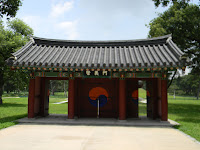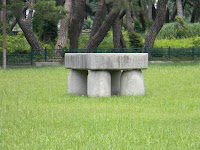We then drove a few minutes away to the Oreung Tombs, which are believed to house the remains of the first king of Silla, his queen (also born from an egg near these burial grounds), as well as the second, third, and fifth kings of Silla. Again, these mounds are similar to those of the North American mound builders. Also, around the grounds there are Confucian style structures for ancestor remembrance ceremonies; this is important in that Confucian philosophies were not a part of Korean religious life during the era of these kings and were added later in time.
Following a stop for lunch, and seeing MANY more burial mounds throughout the country-side from the windows on the bus, we went to Seokguram Grotto and its accompanying Bulguk-sa Temple. Seokguram features a large white granite statue of the Buddha. Rather than being placed inside of a preexisting cave, the creators of this Buddha built a chapel cave to surround the statue. Mark Peterson, the professor I previously mentioned in "Icons of Korean Language", noted that Buddhas within a cave were a symbol of safety along the silk road from western Asia (Middle East) all the way to East Asia. The Seokguram Grotto Buddha is the eastern most Buddha within a cave and, thus, a marker for the eastern most extent of the silk road. A small temple outside of this grotto displays thousands of colorful lanterns on which written prayers are placed.
About 3 km away from the grotto is the primary temple which would oversee the care of the Seokguram Buddha. Bulguk-sa Temple was built during the reign of Silla King Beopheung who reigned from 514-540. The temple, as well as the Buddha in the grotto, have been listed as UNESCO World Heritage Sites.






















No comments:
Post a Comment